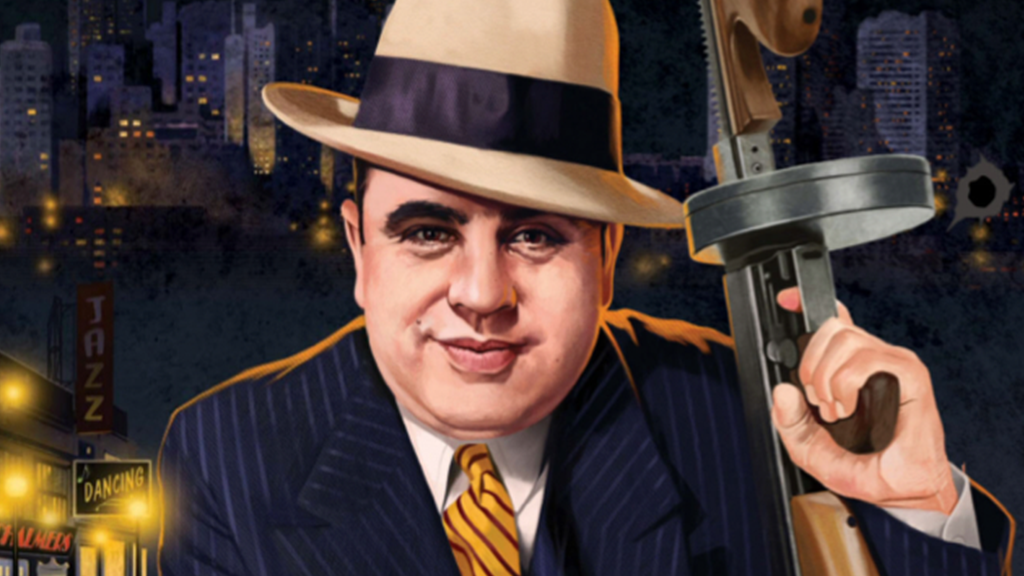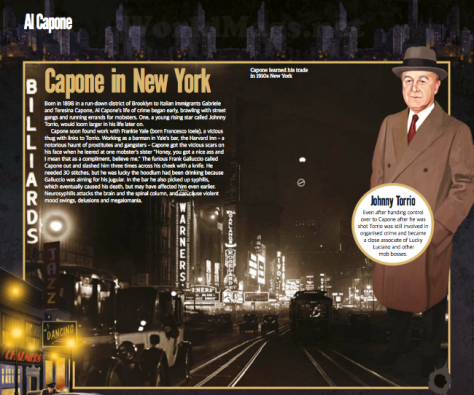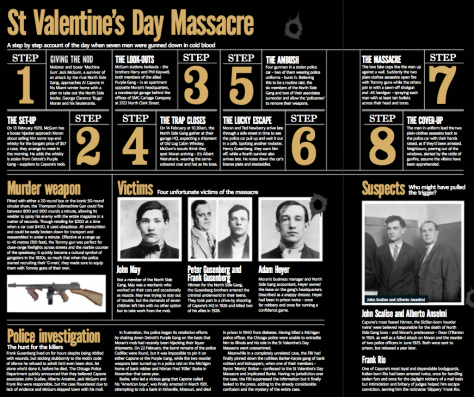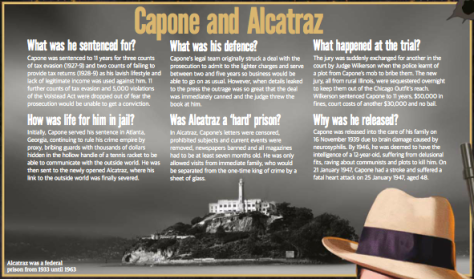Arriving in Chicago as a minor league mobster, Al Capone helped build an empire of prostitution, bootlegging and murder that made him a notorious household name.
The needle skipped as the gun barked twice in the killer’s hand, the record player screeching into the silence of the restaurant’s corridor as its owner crashed to the floor, blood pooling out onto the polished tiles.
Giacomo ‘Big Jim’ Colosimo, his body cooling from its exit wounds, had recently left his wife, filing for divorce and skipping town to marry a 19-year-old cabaret singer. His ex-wife, Victoria Moresco, or one of her brothers, was the prime suspect in this crime of passion, but the police knew enough to pay a visit to two of Colosimo’s associates – the genial Johnny Torrio and his sidekick, the disquieting Alfonse Capone, three nasty scars on his cheek contorting as he smiled. “Big Jim and me were like brothers,” claimed Torrio. “Mr Colosimo and me both loved opera”, added Capone. “He was a grand guy.” Colosimo’s murder on 11 May 1920 is still regarded as unsolved, but perhaps it’s a crime that Chicago Police Department chose to leave that way. For nearly a decade Colosimo had ruled Chicago through hard graft and intimidation – running over 100 brothels with his wife – and extorting protection money from most of the city’s illegal gambling dens, the profits snaking through the entire city, supplementing the meagre wages of the cop on the street corner and boosting the bank account of the city’s two-time mayor, William ‘Big Bill’ Hale Thompson.
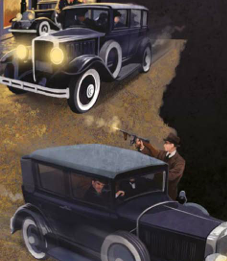 Chicago was a rough town. Booming in the early 1920s thanks to heavy industry and cheap labour, the Windy City was a Wild West frontier town with chimney stacks instead of cacti and bullet- riddled Model-T Fords in lieu of horses. “She was vibrant and violent,” wrote local journalist Robert St John, “stimulating and ruthless, intolerant of smugness, impatient with those either physically or intellectually timid.”
Chicago was a rough town. Booming in the early 1920s thanks to heavy industry and cheap labour, the Windy City was a Wild West frontier town with chimney stacks instead of cacti and bullet- riddled Model-T Fords in lieu of horses. “She was vibrant and violent,” wrote local journalist Robert St John, “stimulating and ruthless, intolerant of smugness, impatient with those either physically or intellectually timid.”
Capone had arrived in Chicago from New York in 1919 to work for his old friend Torrio, who had earned Colosimo’s trust by chasing off a rival extortion racket and stuck around as the boss’s second in command. Capone soon put the feared reputation he had enjoyed back home to work as a debt collector, seeing first hand how Colosimo’s operation held a stranglehold over the underworld; gambling dens who refused to pay up for Big Jim’s protection would either find themselves the subject of a convenient police raid or – worse still – a visit from Capone, who was more than happy to break a few legs and mess up a card table with a swing from his baseball bat.
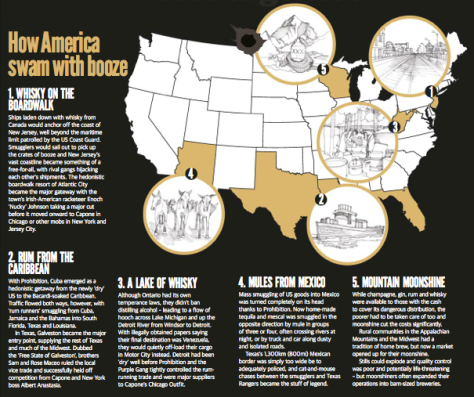 Compared to the claustrophobic Big Apple, where half a dozen gangs butted heads over a block at a time, Torrio and Capone found Chicago fertile for expansion, as the only thing that stood in their way was their own boss. In January 1920 the rules of the game changed again as the 18th Amendment to the US Constitution came into effect. Also known as the Volstead Act, which prohibited the production, transportation and sale of alcohol – but not the consumption – Prohibition meant a huge swathe of the population were suddenly transformed into potential customers. Torrio and Capone saw that this was a revenue stream with the potential to dwarf even prostitution and racketeering, but to their dismay Colosimo was having none of it. When Colosimo was conveniently removed from the picture, John ‘The Fox’ Torrio became the boss of the Chicago
Compared to the claustrophobic Big Apple, where half a dozen gangs butted heads over a block at a time, Torrio and Capone found Chicago fertile for expansion, as the only thing that stood in their way was their own boss. In January 1920 the rules of the game changed again as the 18th Amendment to the US Constitution came into effect. Also known as the Volstead Act, which prohibited the production, transportation and sale of alcohol – but not the consumption – Prohibition meant a huge swathe of the population were suddenly transformed into potential customers. Torrio and Capone saw that this was a revenue stream with the potential to dwarf even prostitution and racketeering, but to their dismay Colosimo was having none of it. When Colosimo was conveniently removed from the picture, John ‘The Fox’ Torrio became the boss of the Chicago
Outfit, and by his side stood Al Capone. With Torrio’s blessing, Capone set about covertly reopening breweries and distilleries that had been closed by the Volstead Act, setting up an ambitious distribution network to the city’s mean speakeasies with the help of his older brothers Ralph and Frank Capone. “Nobody wanted Prohibition,” he said. “This town voted six to one against it. Somebody had to throw some liquor on that thirst. Why not me?”
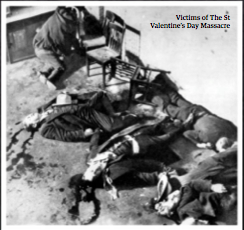 The loyal Ralph was put in charge of one of the Chicago Outfit’s legal enterprises, a soft-drink bottling plant which earned him the nickname ‘Bottles’, while Frank honed a reputation for savagery that overshadowed even Al’s. Estimated to have been responsible for 300 deaths, Frank infamously advised his little bother that, “you get no talk back from a corpse.”
The loyal Ralph was put in charge of one of the Chicago Outfit’s legal enterprises, a soft-drink bottling plant which earned him the nickname ‘Bottles’, while Frank honed a reputation for savagery that overshadowed even Al’s. Estimated to have been responsible for 300 deaths, Frank infamously advised his little bother that, “you get no talk back from a corpse.”
It was happening under Johnny Torrio’s command but there was no doubt that bootlegging was Al Capone’s kingdom, and he was soon to pay for it in blood as 1923 saw the downfall of Chicago’s sticky fingered mayor, ‘Big Bill’ Thompson. The Democrat William Emmett Dever was voted in on a pledge to sweep the gangs from the city, and Torrio entrusted Capone with an urgent relocation to Cicero – the
fourth largest city in Illinois – just outside of Chicago and the legislative reach of ‘Decent Dever.’ While Torrio and Capone had ruled their criminal empire largely as Colosimo had – with money in the right pockets and threats whispered in the right ears – the takeover of Cicero was an overt display of force, as Capone set about rigging the mayoral election for the mob’s pet politician, Joseph Z Klenha.
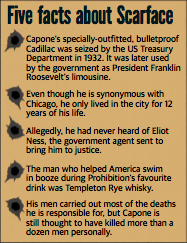 On the eve of the 1924 mayoral election, Frank Capone burst into the office of the Democrat candidate for Cicero with some of his thugs, beating the hopeful to a pulp with their pistol butts, trashing his office and firing their revolvers into the ceiling as a preamble for the next day’s audacious takeover. As cold, grey 1 April dawned, Capone hoods stormed into the polling stations to screen voters, snatching their ballot papers from them to ensure they were ticking the right box. Election officials with the stones to intervene were dealt with; a Democrat campaign worker was shot in the legs and dumped in a cellar, two other men were shot in the street and another had his throat cut.
On the eve of the 1924 mayoral election, Frank Capone burst into the office of the Democrat candidate for Cicero with some of his thugs, beating the hopeful to a pulp with their pistol butts, trashing his office and firing their revolvers into the ceiling as a preamble for the next day’s audacious takeover. As cold, grey 1 April dawned, Capone hoods stormed into the polling stations to screen voters, snatching their ballot papers from them to ensure they were ticking the right box. Election officials with the stones to intervene were dealt with; a Democrat campaign worker was shot in the legs and dumped in a cellar, two other men were shot in the street and another had his throat cut.
Eventually, a desperate judge bussed in 70 Chicago police officers, deputised on the spot into the Cicero Police Department, to restore order. As the rain started to fall, Frank Capone found himself in a firefight outside a polling station. Opening fire on an approaching police car, he was gunned down by the startled cops, but it was too late – the town belonged to the Chicago Outfit. Frank got a funeral fit for war hero, with $20,000 worth of flowers placed around the silver plated coffin and over 150 cars in the motorcade.
 Despite the appalling bloodshed in the takeover of Cicero, Al Capone had been something of an enigma to the press. However, as he got his hands dirtier and dirtier and frequently acted unstably – a possible consequences of syphilis contracted back in New York – his name was beginning to be heard outside of darkened back rooms where shady men made deals. A few weeks after Frank’s body hit the pavement, small- time burglar ‘Ragtime’ Joe Howard was enjoying a drink in a bar, when two men entered. Witnesses, who quickly forgot all the other details, recalled him say a friendly “Hello Al” before he was shot point blank – four rounds into his cheek and two into his shoulder. Nobody saw anything, nobody recognised the man, but the police knew who was responsible and so did the press, so for the first time, Capone’s mugshot appeared on the front page.
Despite the appalling bloodshed in the takeover of Cicero, Al Capone had been something of an enigma to the press. However, as he got his hands dirtier and dirtier and frequently acted unstably – a possible consequences of syphilis contracted back in New York – his name was beginning to be heard outside of darkened back rooms where shady men made deals. A few weeks after Frank’s body hit the pavement, small- time burglar ‘Ragtime’ Joe Howard was enjoying a drink in a bar, when two men entered. Witnesses, who quickly forgot all the other details, recalled him say a friendly “Hello Al” before he was shot point blank – four rounds into his cheek and two into his shoulder. Nobody saw anything, nobody recognised the man, but the police knew who was responsible and so did the press, so for the first time, Capone’s mugshot appeared on the front page.
In private, Capone’s gang whispered that Howard had stuck up Jack ‘Greasy Thumb’ Guzik for $1,500, boasting he had “made the little Jew whine.” Guzik was Capone’s trusted money man, responsible for regular payoffs to cops and judges. Soon the name ‘Scarface’ began to stick, needling away at Capone’s vanity – he never allowed the left side of his face to be photographed – and he began to lash out at the flickering flash bulbs of the photographers.
There were far more immediate threats than damning headlines, though. The predominantly Irish-American North Side Gang run by Dean O’Banion controlled the breweries and the bootlegging in Chicago’s North Side and had resisted all of Torrio’s efforts to bring them to heel. Alliances and truces had dwindled and fallen apart, but the last straw came on 19 May 1924 as O’Banion finally relinquished his share of the Sieben Brewery to Torrio. As soon as Torrio and his boys – joined by their allies in Little Sicily’s ‘Terrible Gennas’ – showed up, a conveniently timed police raid swept in and the boss was left with a $5,000 fine and a nine-month jail sentence. “Deany was all right,” smirked Capone, who took over the day-to-day running of the mob while Torrio served his sentence. “But like everyone else, his head got away from his hat.”
One day while O’Banion clipped chrysanthemums in his flower shop, Schofields, Mike ‘The Devil’ Genna, John Scalise, Albert Anselmi and Frankie Yale strode in. As O’Banion and Yale shook hands, Scalise and Anselmi fired two bullets into his chest and two into his throat. As he lay on the floor in a pool of blood and petals, he was shot in the back of the head for good measure. He had been dealt with.
George Clarence ‘Bugs’ Moran took over the North Side Gang and nursed their grudge, moving the headquarters from Schofields to the garage that would become the site of the shocking
St Valentine’s Day Massacre in 1929, the culmination of a brutal and bloody five-year gang war between the Chicago Outfit and the North Side Gang.
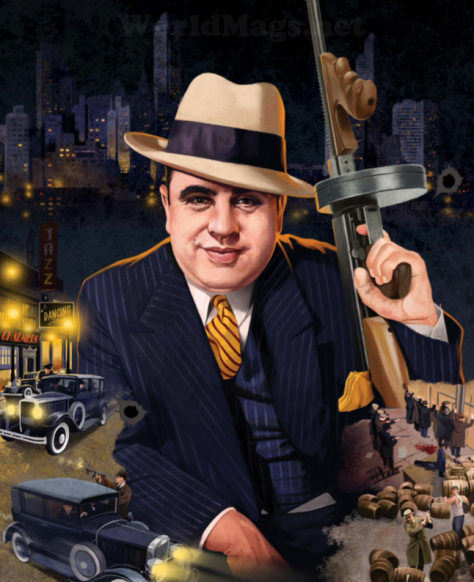 Upon his release Torrio kept a low profile – safe in the knowledge that with Capone in the hot seat, he’d be less of a target. For all of the Fox’s wiles, he just hadn’t reckoned on how personal this war had become.
Upon his release Torrio kept a low profile – safe in the knowledge that with Capone in the hot seat, he’d be less of a target. For all of the Fox’s wiles, he just hadn’t reckoned on how personal this war had become.
Returning from a day shopping with his wife on the morning of 24 January 1925, gunfire lit up the street from a blue Cadillac lurking on the curb, shredding shopping bags to confetti. Blood mingled with the groceries from a litany of wounds as Johnny Torrio stared at the sky, the shrieking of Anna Torrio strangely distant. As Bugs Moran stood over him, blocking the crisp winter sun, his revolver levelled at Torrio’s skull – the gun clicked on empty and the would-be assassins fled.
Capone’s ascendancy was immediate as Torrio underwent emergency surgery. Capone slept by his mentor’s bedside – the men of the Chicago Outfit standing guard around the clock, eying each disinterested nurse and flower-clutching day visitor suspiciously. “It’s all yours, Al,” said Torrio eventually. “Me? I’m quitting. It’s Europe for me.”
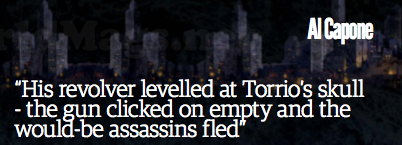 With the Fox quietly returning to Italy, Capone moved his headquarters into Chicago’s luxurious Lexington Hotel, taking over the fourth and fifth floors where he held court like an emperor, surrounded by mobsters and prostitutes. A concrete vault was installed in the basement and a secret staircase hidden behind a mirror in one of his bathrooms, just one part of a web of tunnels that would allow him a quick escape. Rising late most days, he took his time pouring over the morning papers like a statesman, before dressing himself in expensive finely tailored suits. Early afternoon, Capone moved
With the Fox quietly returning to Italy, Capone moved his headquarters into Chicago’s luxurious Lexington Hotel, taking over the fourth and fifth floors where he held court like an emperor, surrounded by mobsters and prostitutes. A concrete vault was installed in the basement and a secret staircase hidden behind a mirror in one of his bathrooms, just one part of a web of tunnels that would allow him a quick escape. Rising late most days, he took his time pouring over the morning papers like a statesman, before dressing himself in expensive finely tailored suits. Early afternoon, Capone moved
into his study in another suite where petitioners waited anxiously for favours and his patronage. Nobody talked about the “Free Kingdom of Torrio” anymore. No, now the press called Cicero the “Capital of Caponeland.”
Capone began to court newspaper men, handing out expensive cigars and inviting them to lavish parties, where the lord of the Chicago underworld played billiards with boxers, baseball players and the notoriously corrupt mayor of Chicago, Big Bill Thompson, miraculously re-elected in 1927. “Public service is my motto,” Capone explained to attentive reporters in December 1927. “99 per cent of the public in [Chicago] drink and gamble and my offense has been to furnish them with those amusements. My booze has been good and my games on the square.” Already the public had some sympathy for the bootleggers and Capone took hold of the notion and twisted it into the spectre of Robin Hood, portraying himself as heroic outlaw giving the people what they wanted.
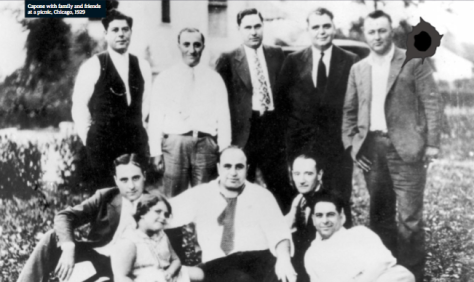 The bigger Capone’s business became, the more intricate and vulnerable the network of mobsters, bribes and alliances required to sustain it. It got to a point where the endemic corruption of Chicago’s law and government simply couldn’t be ignored. In the wake of the shocking St Valentine’s Day Massacre, Herbert Hoover was elected US president on an anti-corruption platform. His first move was to dispatch Prohibition agent Eliot Ness and a handpicked team of incorruptible ‘Untouchables’ to clean up Chicago’s streets by raiding Capone’s speakeasies and stills, and more importantly, it transpired, a team of IRS agents headed by accountant-turned-lawman Frank J Wilson with a mandate to turn over Capone’s finances for something that would stick in court.
The bigger Capone’s business became, the more intricate and vulnerable the network of mobsters, bribes and alliances required to sustain it. It got to a point where the endemic corruption of Chicago’s law and government simply couldn’t be ignored. In the wake of the shocking St Valentine’s Day Massacre, Herbert Hoover was elected US president on an anti-corruption platform. His first move was to dispatch Prohibition agent Eliot Ness and a handpicked team of incorruptible ‘Untouchables’ to clean up Chicago’s streets by raiding Capone’s speakeasies and stills, and more importantly, it transpired, a team of IRS agents headed by accountant-turned-lawman Frank J Wilson with a mandate to turn over Capone’s finances for something that would stick in court.
“Every time a boy falls off a tricycle, every time a black cat has gray kittens, every time someone stubs a toe, every time there’s a murder or a fire or the Marines land in Nicaragua, the police and the newspapers holler, ‘Get Capone!’“ raged Chicago’s premier gangster in his penthouse. “I’m sick of it.”
 As the gangster was having a tantrum, one of the men tasked with bringing him to justice was having second thoughts. “Doubts raced through my mind as I considered the feasibility of enforcing a law which the majority of honest citizens didn’t seem to want,” Ness admitted in his autobiography. “I felt a chill foreboding for my men as I envisioned the violent reaction we would produce in the criminal octopus hovering over Chicago, its tentacles of terror reaching out all over the nation. We had undertaken what might be a suicidal mission.”
As the gangster was having a tantrum, one of the men tasked with bringing him to justice was having second thoughts. “Doubts raced through my mind as I considered the feasibility of enforcing a law which the majority of honest citizens didn’t seem to want,” Ness admitted in his autobiography. “I felt a chill foreboding for my men as I envisioned the violent reaction we would produce in the criminal octopus hovering over Chicago, its tentacles of terror reaching out all over the nation. We had undertaken what might be a suicidal mission.”
While Capone wallowed in fine silks and syphilitic megalomania in his penthouse, Ness and his Untouchables began nipping at his heels – shutting down 18 stills and arresting 52 bootleggers in a single night. In the first six months alone, Ness’ daring raids had cost the Chicago Outfit an estimated $1,000,000, as well as some of loyal lieutenants, who now languished in jail for violations of the Volstead Act. He shrugged off Capone’s clumsy attempts at bribery, as well as two assassination attempts.
It was only ever an irritant, taking chunks out of his income and his pride – but to a mobster as egotistical as Capone, such defiance drove him into a rage. It was a fury Ness gleefully exploited – parading captured vehicles outside his hotel and taunting him on the phone. However much Ness might have damaged

